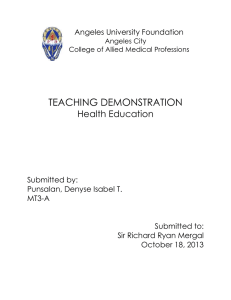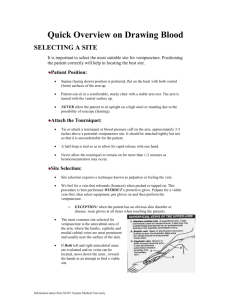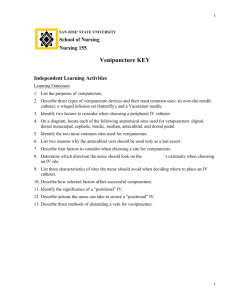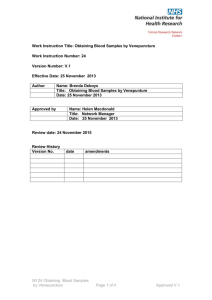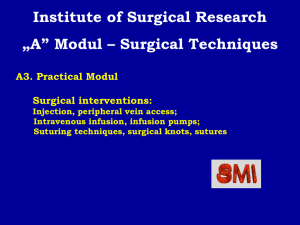Venous blood collection presentation
advertisement
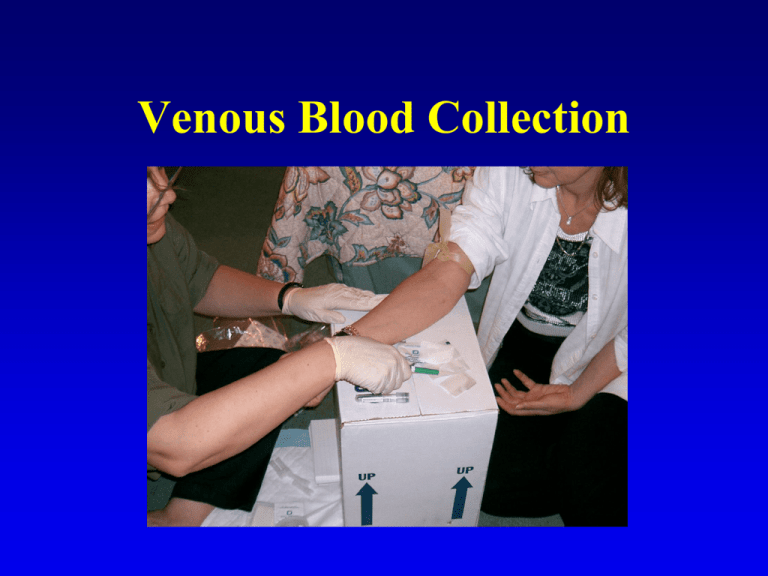
Venous Blood Collection General instructions 1. Once survey participant has been selected, choose a comfortable place to set up the biological sampling station. 2. Lay out a clean disposable mat with all the equipment necessary to collect blood samples. 3. For each participant, wear new gloves and conduct all procedures on a clean disposable mat. 4. After transferring any biological sample into the Vacutainer tubes, immediately label all samples accurately. Universal precautions • Assume that all human blood is potentially infectious for HIV, hepatitis, and other infectious agents. • Practice Universal Precautions using gloves, eye protection, and lab coats. • Always use sterile, singleuse, disposable supplies for sample collection. Venipuncture procedure 1. Make sure participant is sitting comfortably. 2. Lay out all blood collection supplies and necessary labels. Assemble needle or butterfly needle into Vacutainer holder being sure that it is firmly seated into threads. Loosely place Vacutainer tube into holder, but do not puncture top. 3. Examine both arms to find the best vein. Locate the puncture site; apply the tourniquet. Venipuncture procedure 4. Locate the vein and cleanse the area with an alcohol wipe. Wipe the area in a circular motion making sure the area is thoroughly cleaned. Repeat with a second wipe, if necessary. 5. Dry with gauze. Venipuncture procedure 6. If it is necessary to feel the vein again, do so, but cleanse the area again with an alcohol wipe and dry with gauze. 7. Fix the vein by pressing down on the vein about 1 inch below the proposed point of entry and pull the skin taut. 8. Remove the needle shield. Venipuncture procedure 9. Approach the vein in the same direction the vein is running, holding the needle so that it is at an approximately 15° angle with the participant's arm. Venipuncture procedure 10. Push the needle, with bevel facing up, firmly and deliberately into the vein. Activate the vacuum collection tube by pushing the tube onto the needle and puncturing the tube top. If the needle is in the vein, blood will flow freely into the tube. If no blood enters the tube, probe for the vein once or twice until entry is indicated by blood flowing into the tube. Venipuncture procedure 11. For collection, loosen the tourniquet immediately after blood flow is established and release entirely as the last tube fills. 12. If a syringe is required to obtain the blood, attach it to the appropriate size butterfly needle and withdraw 2-3 mL blood. After withdrawing the needle from the arm, quickly change the needle on the syringe and transfer blood from the syringe by puncturing the top of the tube with the new needle and allowing the vacuum to draw the blood into the tube. Mix well with the anticoagulant. Venipuncture procedure 13. Withdraw the tube, then the needle. Heavy pressure as the needle is being withdrawn should be avoided. 14. When the needle is out of the arm, press gauze firmly on the puncture. 15. Have the participant raise his arm (not bend it) and continue to hold the gauze in place for several minutes. This will help prevent hematomas. Venipuncture procedure 16. Report to the supervisor any reaction experienced by the participant during the venipuncture procedure. 17. Place a bandage on the participant's arm. 18. Label all tubes with the preprinted labels provided. Write date on label with permanent marker (if not preprinted). Venipuncture procedure 19. You may resheath the needle, but only with proper technique. With the needle top on the absorbent pad, slowly slide the needle into the needle top. 20. The needle should be discarded into a sharps container. Place all labeled tubes in a cool box, and discard waste into biohazard container.

